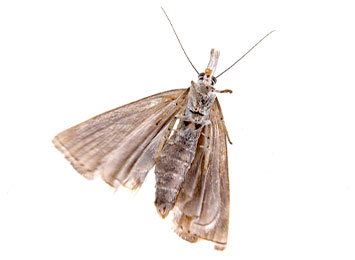What do Webbing Clothes Moths Look Like?
Size: Adult moths are about ¼” long, with a ½” wingspan. Larvae are around ¼ to ½” long and “pill” shaped.
Color: Adult moths are gold, wheat-yellow, or tan with small red-gold hairs on their heads. Wings are slightly lighter in color and have small golden hairs spanning their length. The lower pair of legs tend to be lighter than the upper pair. Larvae are white or off-white and have brown or black heads.
Clothes Moth Control and Prevention
Consider storing garments in sealed plastic clothing protectors. Take special care to store fabric made of natural fibers in airtight, sealable containers to prevent moths from accessing them. Make sure storage areas are clean and dry.
If you find clothing moths, dispose of all obviously infested materials immediately. Wash all the fabrics you stored in the same location. Transfer the clothing into plastic protectors immediately after washing it.
Webbing Clothes Moth Behavior and Diet
Webbing clothes larvae feed on natural fibers such as human hair, rodent hair, wool, fur, and feathers. They don’t usually feed on synthetic fabric, but they may do so if the fabric contains human perspiration or body oils.
Adult clothing moths do not feed. In fact, they don’t even have mouths! Instead, the adults mate, deposit eggs on food sources, and die shortly thereafter. Both adult and larval webbing clothes moths are nocturnal. They feed, mate, and locate food sources at night and hide during the day.
Clothes Moth Reproduction and Life Cycle
Female adult fabric moths lay an average of 40 to 50 eggs on promising food sources and die shortly thereafter. The time it takes to hatch is based on the temperature of their environment. In warm environments, the eggs could hatch 4 to 10 days.
After hatching, larvae begin feeding and growing immediately. As larvae grow, they will molt continuously up to 45 times. Depending on temperature and food availability, moths could remain larvae for only 35 days or up to 2 and a half years. After they’ve finally eaten and grown enough, larvae pupate inside silk cocoons. Pupation takes between 1 and 4 weeks and newly emerged adult moths are ready to mate immediately.
Other Clothes Moth Characteristics
Unlike many other moth species, webbing clothes moths are not particularly capable fliers. They only fly for short distances and tend to stay in place longer than most moths.
Webbing clothes moths are not attracted to light. In fact, they tend to actively avoid well-lit areas and seek out dark, secluded hiding places instead.
Moth larvae often incorporate their pupal cases in the fabric or fur they’re feeding on. You may find pupae in silk cases on infested clothing.
Call Assured Environments for Clothes Moth Control Services
Webbing clothes moths can be a real nuisance and cut into the profits of certain industries. They can also chew on carpeting and make any other building look shabby in the process. No matter which industry you’re in, our team can give you a hand with webbing clothes moth control.
Give us a call to get started with a free inspection!


